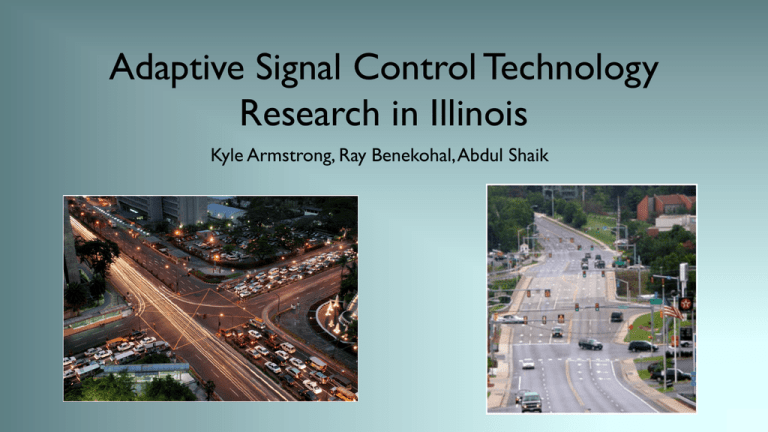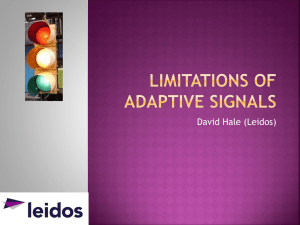Adaptive Signal Control Technology Research in Illinois
advertisement

Adaptive Signal Control Technology Research in Illinois Kyle Armstrong, Ray Benekohal, Abdul Shaik Overview • • • • • • ASCT ASCT Research Before Study SynchroGreen Implementation After Study Future Direction What is Adaptive Signal Control Technology (ASCT)? • Continuously adjusts traffic signal timings to accommodate real-time changes in traffic patterns and to improve traffic flow • Several manufacturers and products with different methodologies for adjusting timings • Some systems may only require software upgrades while others may require additional controller and detection hardware • Included in first round FHWA’s Every Day Counts Initiative which helps promote and advance implementation of proven technologies Benefits of ASCT • Improves travel times through coordinated signal system • Allows more flexibility and adjustments for sudden changes in traffic patterns. • Reduces number of vehicle stops and wait times leading to reduced fuel consumption • Reduced number of crashes? Purpose of ASCT research • Determine if there is a reduction in crashes due to ASCT implementation (rear-end crashes & left turn crashes) • Develop a Crash Modification Factor (CMF) for ASCT implementation • Measure improvements in traffic flow and efficiency • Implementation site can be used as a test bed for future ASCT training and research Purpose of ASCT Research • Testimonials and information from manufacturer websites typically show improved traffic flow and efficiency benefits • There appears to be minimal research and information regarding potential safety benefits of ASCT • Reduction in stops should help reduce rear-end crashes • Flexibility in adjusting individual phase times particularly for left turning traffic could reduce angle crashes Research Quick Research • Gathered crash and cost data from agencies outside Illinois • Data acquired through user surveys Full Research • Installed ASCT system along Neil St. in Champaign • Gathering before and after efficiency and crash data • Develop CMF for ASCT implementation Quick Research • Wanted to see which agencies had implemented ASCT and if they had performed post-implementation studies • Completed January 2013 with over 20 agencies responding • Average cost per intersection, $38k • Data showed reduction, but very limited sample size • Enough to move forward with full implementation and study Full Research - Overview • Initially 3-year project beginning in 2013 • Phase 1 – Select test site, perform systems engineering analysis, collect pre-implementation data • Phase 2 – Purchase and install ASCT system, postimplementation data, develop benefit-cost and CMF information Full Research – Phase 1 • Selection of Test Site • No recent significant safety improvements • Recently studied for coordination • High variance of traffic volumes • Selected Neil St. corridor in Champaign • Acquired pre-installation data • Performed systems engineering analysis based on requirements and needs for the Neil St. system Full Research – Systems Engineering Analysis and Selection/Procurement • Method to outline and determine proposed ASCT system capabilities • Very technical analysis. Signal personnel should be involved • TRP developed requirements and scored ASCT vendor proposals • State procurement process was difficult Full Research – Phase 2, ASCT System • Trafficware SynchroGreen system selected • Installed April 2015 with full acceptance November 2015 • System required video detection installation • Allowed vendor to adjust detection and timing programs Full Research – Phase 2 • Primary goal is to develop a Crash Modification Factor in accordance with recommendations from NCHRP 20-7(314) • Consider including in Crash Modification Factor Clearinghouse and Highway Safety Manual TRP Members Mike Hine (FHWA) Dean Mentjes (FHWA) Chris Dipalma (FHWA) Kevin Burke (BLRS) Tom Winkelman (BLRS) Irene Soria (BSE) Tim Sheehan (BSE) Kristen Micheff (IDOT D1) Eric Howald (IDOT D4) Gary Sims (IDOT D5) David Burkybile (IDOT D5) Mike Irwin (IDOT D6) Jon Nelson (Lake Co.) Yogesh Gautam (IDOT Ops) Glen Berger, City of Champaign Before Data Collection • 12 days of data collected using video recorders for the six intersections (option to choose the best day) in fall 2013 • Data collection periods: Morning 7:00 am – 9:00 am Noon 10:30 am – 1:30 pm Afternoon 4:00 pm – 6:00 pm • 6 days of data collection for travel time using a GPS unit Before Data Reduction • Data reduction periods: Morning 7:10 am – 8:40 am Noon and off peak 10:40 am – 1:15 pm Afternoon 4:40 pm – 6:00 pm • Data reduction items: - Volume - Saturation flow rate - Stopped delay - Signal timing (phase, cycle, green time) - Queue length - Travel time Peak Hours • Volumes obtained manually from videos • Peak hours determined based on volumes at major intersections: Stadium, Kirby, St. Mary, Windsor Morning Peak Noon Peak Afternoon Peak Off Peak selected 7:30 am – 8:30 am 12:10 pm – 1:10 pm 4:40 pm – 5:40 pm 10:40 am – 11:40 am Stopped Delay • Used HCM procedure for field measurement of intersection stopped delay • Extensive data reduction for delay: • For 6 intersections • For 3 or 4 approaches at each intersection • For 4 analysis periods • For 2-3 movement on each approach (left, through, and right) • In every 15 seconds, determined: No. of vehicles stopped No. of vehicles that went through No. of stopped vehicles at the end of 15 sec period Extracted data from about 300 hours of video Queue Length • Queue lengths were observed from the video for thru movements at all intersections for all time periods • Queues observed from videos at the beginning of green phases of each cycle: – Recorded vehicles stopped in queue – Recorded vehicles that joined end of queue Saturation Flow Rate • Found using HCM 2010 procedure 1870 (PM Peak) 1722 (PM Peak) X 1908 (PM Peak) 1923 (AM Peak) 1949 (PM Peak) 1961 (AM Peak) 1894 (AM Peak) Signal Timing • Videos used to record the frequency and duration of the signal phases: – For AM, Noon, and PM peak hours (off peak is same as noon peak) • For each intersection • For each approach • Useful to analyze the system behavior and replicate conditions in HCM Arrival Type • AT 2, 3, and 4 for Neil St thru movements based on field data – AT were estimated based on the proportion of vehicle stopped, and by viewing of video of when platoon arrived during the cycle – AT 2 was for at Kirby NB (PM and Noon), St Mary’s SB (AM) • Random arrivals (AT 3) is used for streets crossing Neil, and for left-turn movements from Neil Travel Time • Recorded GPS coordinates, speed and time every second • • • • It shows variations from Run to run Segment to segment Travel time for each segment or the entire corridor Crash Data • Obtained crash data of 2011-2013 from IDOT • Contains 165 records of crashes in the study area (at intersection = 95 and on links = 70) • Will use 2011-2014 data for before conditions • CMF (crash modification factor) will be developed using before and after crash data Crash Data: Preliminary Analysis Intersection Most Frequent Intersection Crash Type (2011-13) Stadium & Neil Turning (6 out of 11) Kirby & Neil Rear End (22 out of 37) St Mary's & Neil Angle & Rear End (2 out of 6) Devonshire & Neil Rear End (3 out of 3) Knollwood & Neil Rear End (1 out of 1) Windsor & Neil Turning (17 out of 32) SynchroGreen Implementation • • • • • • • • • System installation started Apr 27, 2015 System fine-tuning/software update continued May 4-8, 2015 Further Improvement at Knollwood May 16-18, 2015 4-day SynchroGreen training June 11-14, 2015 Software and settings update July, 2015 Preliminary feedback on system performance sent to vendor Aug 11, 2015 Further feedback and requests was sent to vendor Oct, 21, 2015 Final adjustments completed by vendor Nov 10, 2015 System was accepted Nov 10, 2015 Preliminary Feedback • A 25 page report on system’s performance was sent to Trafficware • Items included in the report: – – – – – Travel time comparison Speed profile on the corridor Volume counts (manually reduced vs. system) Observed queue lengths Observed cycle lengths New Plaza at Neil St & Devonshire • A shopping plaza is construction at the corner of Neil St & Devonshire • Grocery store, hardware store, gas station, hotel and restaurants will generate more traffic Development at Neil St & Devonshire • Right turning-lane added at the intersection • A need to quantify the effects of increased volume due to the development • Developed a methodology for it using capacity analysis Capacity Analysis • Highway Capacity Software (HCS) 2010 was used to perform capacity analysis and analyze effects of volume changes – Capacity analyses was performed for each time period for all 6 intersections using data for before ASCT • Separate HCS file for each intersection were prepared rather than single arterial file – Half-cycle not possible in HCS arterial analysis After Data Collection • Data collected in Dec 2015 using the video detection cameras installed at the intersection • Live video feeds were recorded during off-peak and peak hours • Travel time data will be collected in early March and late April After Study: Present Status • Following data are obtained using same methodology as before – Volume – Delay – Queue lengths • Capacity analysis to account for the real estate development at Neil St & Devonshire • Regularly monitoring the system to ensure its working Future Direction • Collect travel time data • Collect another set of field data in after conditions • Compare measures of effectiveness for operational performance evaluation between before and after conditions – Delay – Queue length – Number of stops • Analyze crash data and develop CMF for safety performance evaluation Thanks! Questions? Kyle Armstrong (Kyle.Armstrong@illinois.gov) Ray Benekohal (rbenekoh@illinois.edu) Abdul Shaik (shaik3@Illinois.edu)
